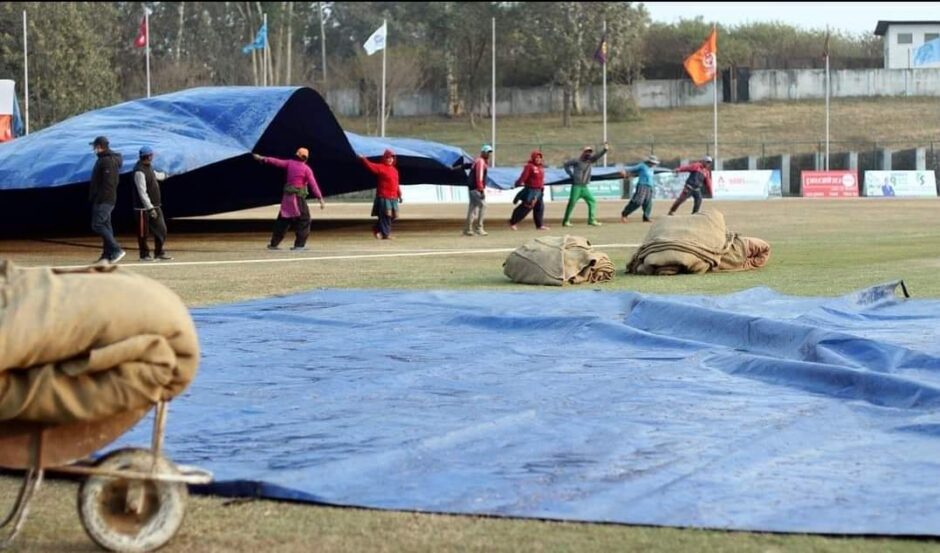A keeper or custodian of a museum or collection. That’s the meaning of curator that comes up when you do a google search. Curators of museums and collections are overlooked for the most part. They do their jobs. They keep things maintained and safe. When it’s all good, no one bothers knowing them. But when something goes wrong, that’s when they’re in the first line of fire. That is the peril of being in the profession.
In cricket, it’s no different. You hardly hear about pitch curators unless the pitch is questioned. And they’re blamed by most, including their own employers who overlook their works themselves. Today, let’s take a few minutes to think about the magic these curators do and how our game has failed them in some ways.
Pitch curators haven’t been around as long as our game. We all have at least once heard old cricket fans write off the records of present batsmen as compared to pre-1970s cricketers with that famed argument of the ‘uncovered pitches’. Before the 70s the pitches were not really maintained. Some were taken care of by a groundsman but that was a rarity.
It was really in the mid-70s that pitch preparation and maintenance became a serious issue in cricket. The term ‘pitch curator’ only started making rounds in the 80s. Today pitch curators and groundsmen are vital members of the cricketing fraternity. So, what do the curators do, and how important their role is? Let us find out.
Pitches, the hallowed turf for the religion that is cricket. It is a game-deciding factor just as much as the players and their abilities. It can turn the fortunes of a game with how it behaves. Before pitch maintenance was a common theme in cricket, the pitches would be dreadful at times. Damp due to rainfall or baked in heat leading to rank turners. The batsmen and even the bowlers were at the mercy of an uncovered and unmanaged pitch.
Players today complain about the pitches, imagine what the conditions were back in the days of our grandads. The demons in the pitch that we talk about nowadays, were real back then. They came out of the turf and consumed your wicket and sometimes it consumed your body.
The advent of better pitch management regulations and most grounds hiring pitch curators and groundsmen to maintain it has changed all that. Along with all the protective gears and analysis of the pitch, the demons have now subdued. All thanks to the hours and hours of work that the groundsmen and curators put into the playing field.
They are the first people to the ground and the last ones to leave. They spend the most amount of time on that cricket field, more than the players. They work year-round to prepare the pitches for a game, taking into all considerations and the factors. In the cathedrals of our game, these are the priests that keep it alive.

Head curators work with multiple groundsmen and prepare the pitches and maintain the outfield. They have to be well versed with the knowledge of not only cricket but the topography of the soil and also the weather along with its effects. Did you know that black soil retains more water, so you can’t water it many days before a game? No? Me neither.
These are the things that curators and groundsmen have to factor in. They decide the best type of soil, the right amount of grass to be left, and make the best possible pitches with the resource available to them. I once remember watching a short documentary about how the bounciest wicket in the world, the WACA pitch, is prepared.
The groundsmen there brought the soil from a wet area and used it to prepare the famed Perth pitch. That is one of the very few times I remember watching a good video on the works of curators and groundsmen. The other times you hear about them is when they’re being criticized. Oh yes, and the time when one curator was adjudged man of the match.
Yes, you read it right. That actually happened. Chris Scott, the curator of Wanderers Stadium in Johannesburg, won the man of the match award in the year 2000 when his team’s work helped the game between South Africa and New Zealand restart and run smoothly even after two days of rain in-between. The groundsmen and the curators have extensive knowledge of the game. Especially the head curators who basically have to be nerds about the playing field aspect of the game.
How much grass should they leave to grow so that the pitch will hold for a 5-day test match? How much water should be put for there to be a balance between bat and ball? How should we prepare the drop-in pitch so that it isn’t a road? What will be the weather forecast and how will it affect the pitch and the outfield? These are very few of the questions that these mud magicians have to deal with. When they are in control, they can dictate some part of the game itself.
And that’s where some problems arise. What happens when a pitch is not up to the so-called ‘sporting standards’? International cricket varies in result vastly with home and away games. There are basic assumptions about how a pitch behaves in a certain country. The seam and swing of England, the pace and bounce of Australia, and the spinning tracks of the sub-continent. These are the features of pitches in different countries that we have come to expect. And the curators are bestowed with the belief of making these pitches that have the perceived characters in each part of the world.
Along with this, they also have to make it so that it holds for the whole five days of a test match so that ICC doesn’t rate it badly. Even in the shorter formats, there are calls to make a pitch so that it doesn’t slow down in the later stages of the game. As you see, the curators have a lot of people to please. And sometimes, their work isn’t deemed to be ‘up to the standard’ by all stakeholders.

Let us take an example of the most recent debacle about cricket pitches in the country that’s all about cricket, India. In the four-match test series between India and England in February, the pitches were all the rage. With two games each being played in Chennai (a ground famous for slow turners) and Ahmedabad (the recently renovated Motera Stadium), the games came thick and fast. And unexpectedly, England swept away the Indians in the first test in Chennai.
The pitch was good as it held well for five whole days. What happened after that match? The curator of the Chennai pitch was removed by the BCCI (with players showing displeasure about how the pitch behaved in the first two days) though he was assigned to prepare the pitch for the second match too. This is what I meant when I said our game has failed the curators and groundsmen. When the blame game begins after a polarizing pitch, it’s usually the curators that come under fire.
The funny thing is, the pitch wasn’t bad. It was a good test match wicket. Yet, BCCI, the management of the strongest team in the world, chose to manage and prepare the pitch under the Indian team management and the chief groundsman, who hadn’t prepared a first-class wicket until the first test. The next test in another pitch of the same ground ended inside four days with English batsmen showing frailties in their technique. The talks about the pitch were subdued. And then came the Ahmedabad tests. The first of the two ended in two days and the second ended in three days.
The pitches were criticized by former English players while the Indian players defended it with ferocity. To be fair the inability of the players to cope with the conditions led to swift endings. The English players who played the tests never complained about the pitch. It was the pundits that did. The former English openers Alastair Cook and Andrew Strauss even said that Virat Kohli, who claimed the pitch to be good, was defending the groundsmen like the BCCI. However, after the first test, we know how the BCCI treated the curator. This fiasco about the pitches proves how precarious the curator’s work is. They are slated by players, pundits, and the public alike.
The praises are very rare. The ratings by match referees determine their performance for real but media coverage stains their work with mostly negative opinions from differing parties. The thing that I found funny which happened in the test series that we talked about, was the fact that the best-rated pitch in the whole series was the first test pitch in Chennai. The BCCI dismissed the curator who prepared the best pitch in the series.
It was rated very good by the match referee. The second and third test pitches were rated average, while the last test pitch was rated good. How is this not a weird thing? And isn’t that dismissal a failure on the part of the BCCI towards the curator? Dhiraj Prasanna, a former curator of Ahmedabad pitch till 2018, said in an interview with News18’s Anand Vasu that curators aren’t allowed to create pitches in their own way these days with suggestions given on what kind of pitches to create.
This happens a lot in Ranji games with the home team wanting pitch decorated to match preferences. Since the curators and groundsmen are employees of the boards, they have to work under them. This has led to even more controversies about pitches and curators. The financial condition in this line of work is also dire. With the influx of money in cricket, the boards and cricketers have been richer. However, these groundsmen that ensure the possibility of cricket to happen, have been left without getting the benefits of that growth.
They still face the same old challenges when it comes to salaries and wages. These failures have led to pitch tampering cases and corruption allegations that have further stained the reputations of curators and groundsmen. Though some of these people may not seem to have the best interest of the game at heart, these people are the heart of our sport. The ones of let the game flow and grow. The ones that prepare and manage the place where cricketers and cricket fans can call home.
As I try to think of the best way to end this article, I remembered a conversation I had with the curator and groundsmen of Mulpani Cricket Ground of our very own country. They said how the governing body of our country hasn’t been able to provide necessary wages and benefits to the workers.
The curator said he was doing the job during the college tournament where I played, purely out of the love for the game as he wasn’t being paid for it by the board. This probably sums up the role of curators in our game. Always there, always important but never appreciated.
Hidden in the underbelly of the glamourous exterior of our game, only to be visible when the situations are bad. We have been failing them for so long, I guess now it’s time for us to uplift these beautiful humans that make the cricketing world go round. It’s time for us to appreciate the guardians of the temples that we cricketing devotees pray in. It’s time to give our dues to the curators and groundsmen that have made the demons go away.







